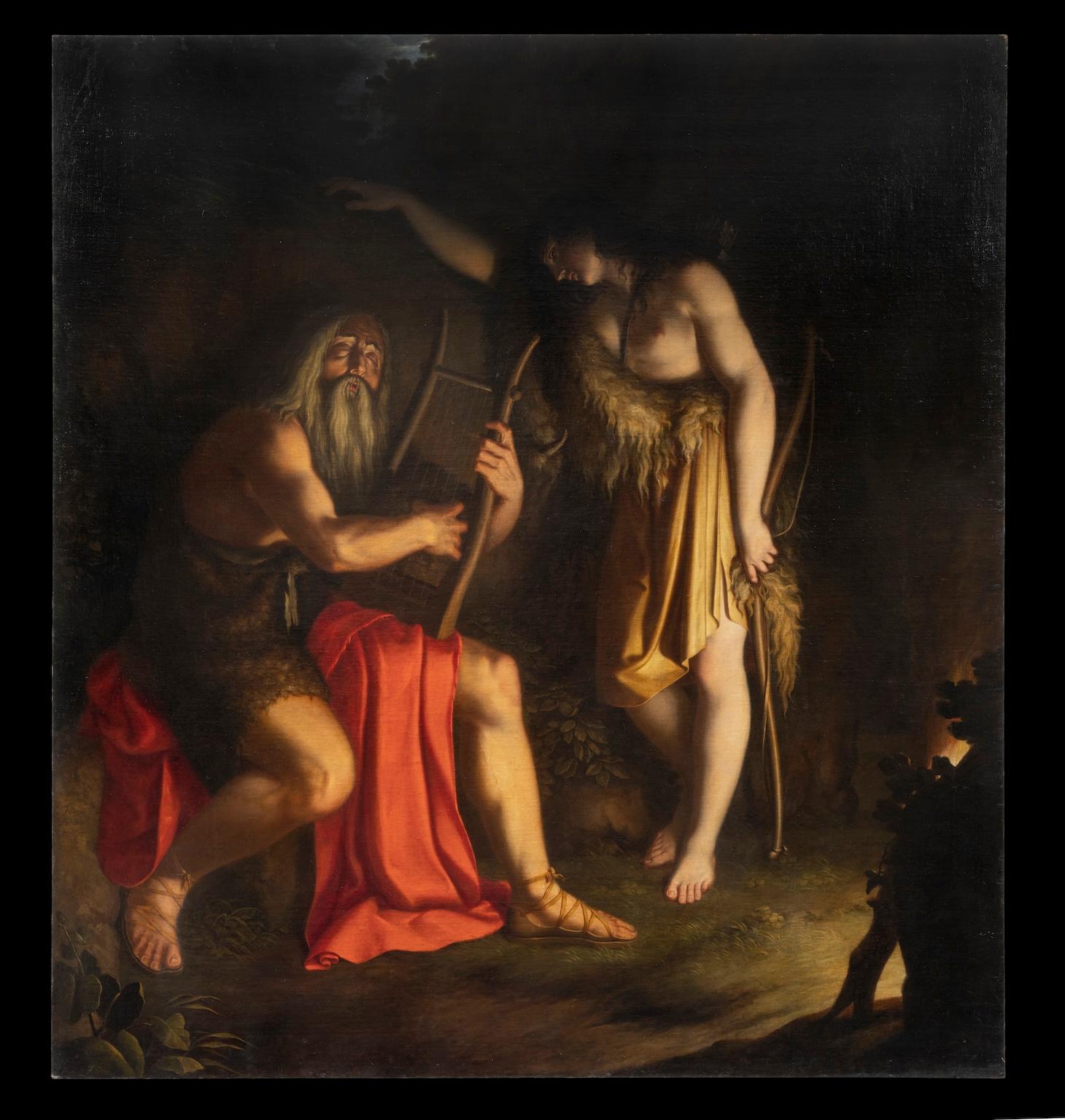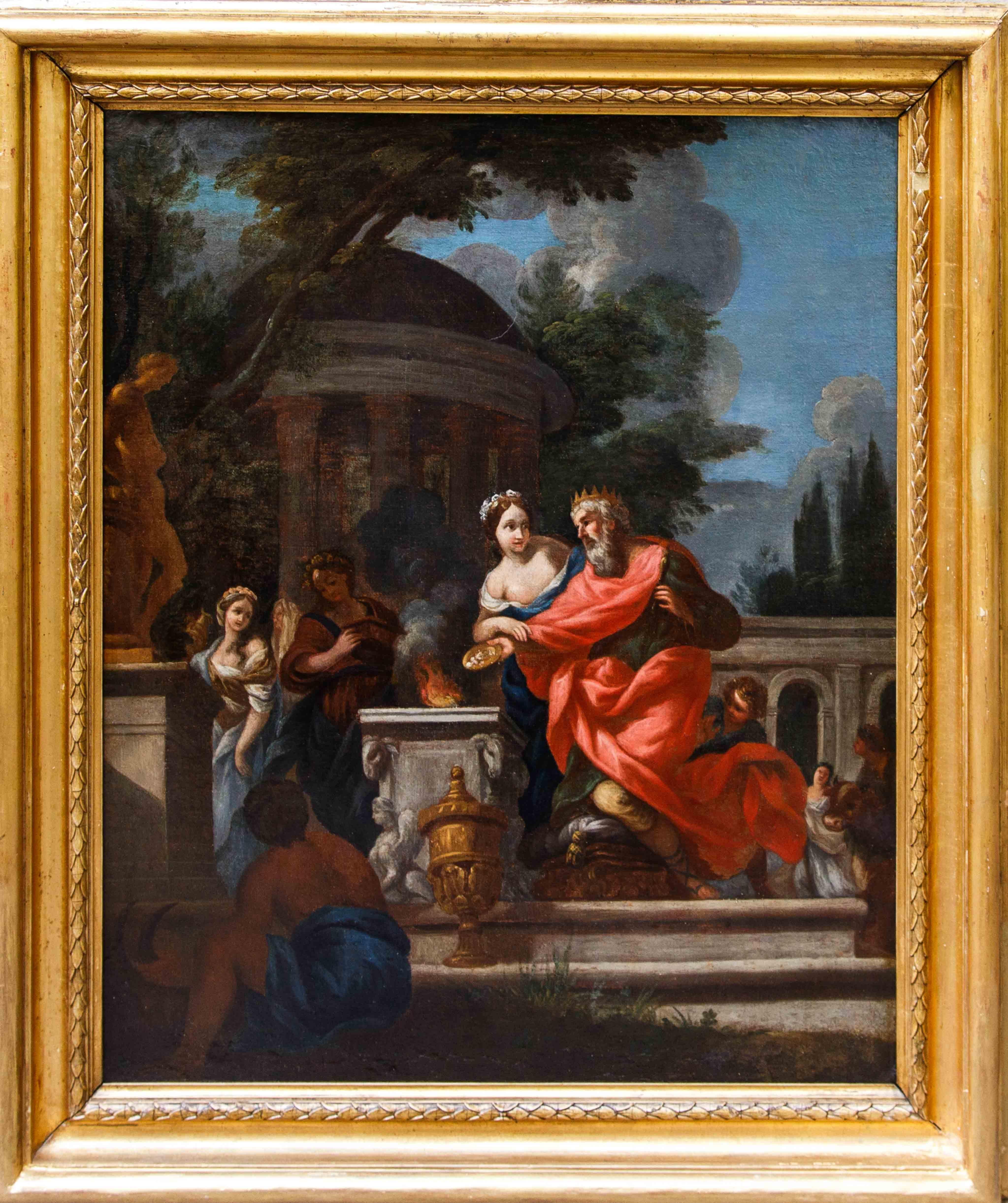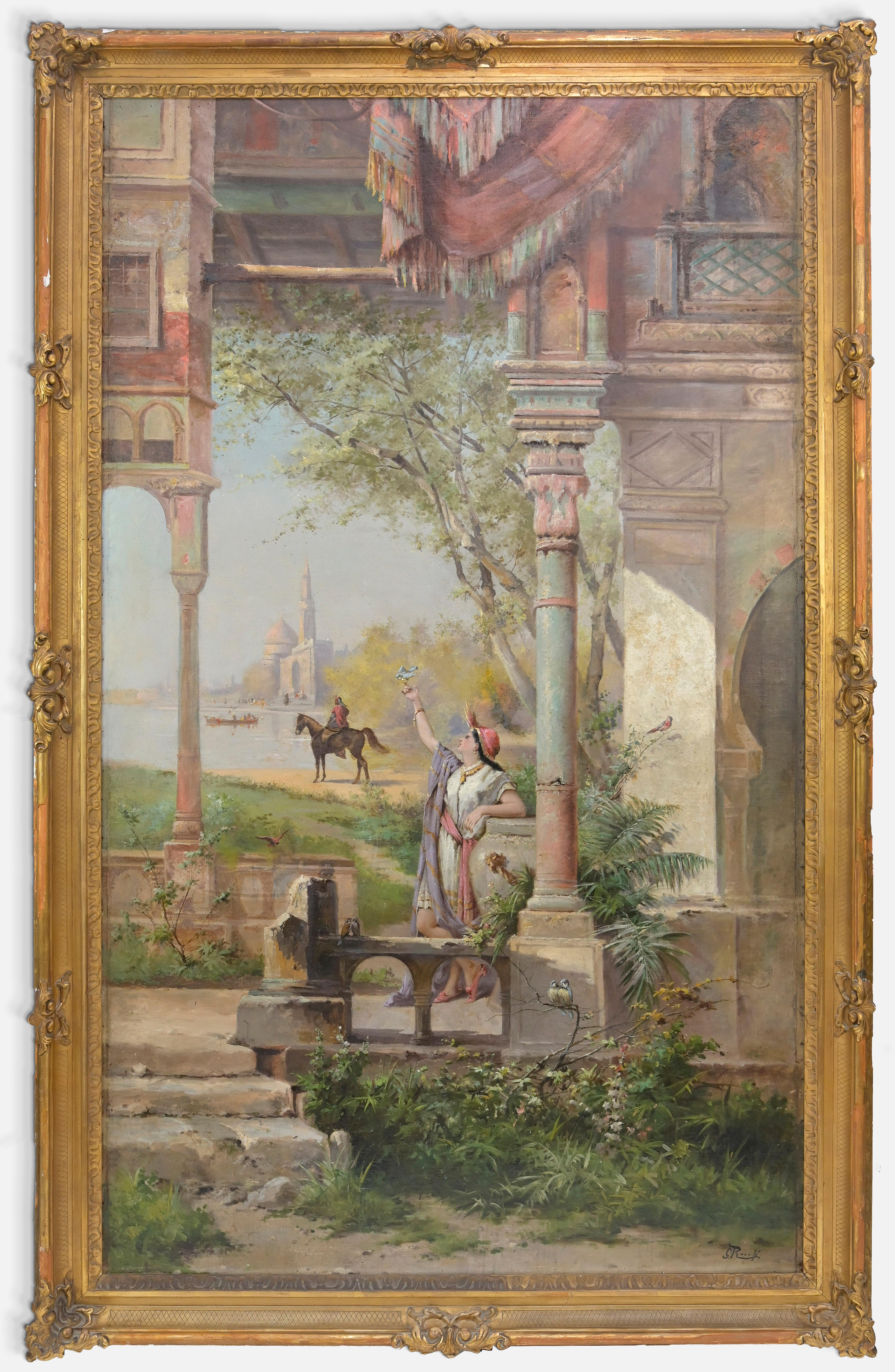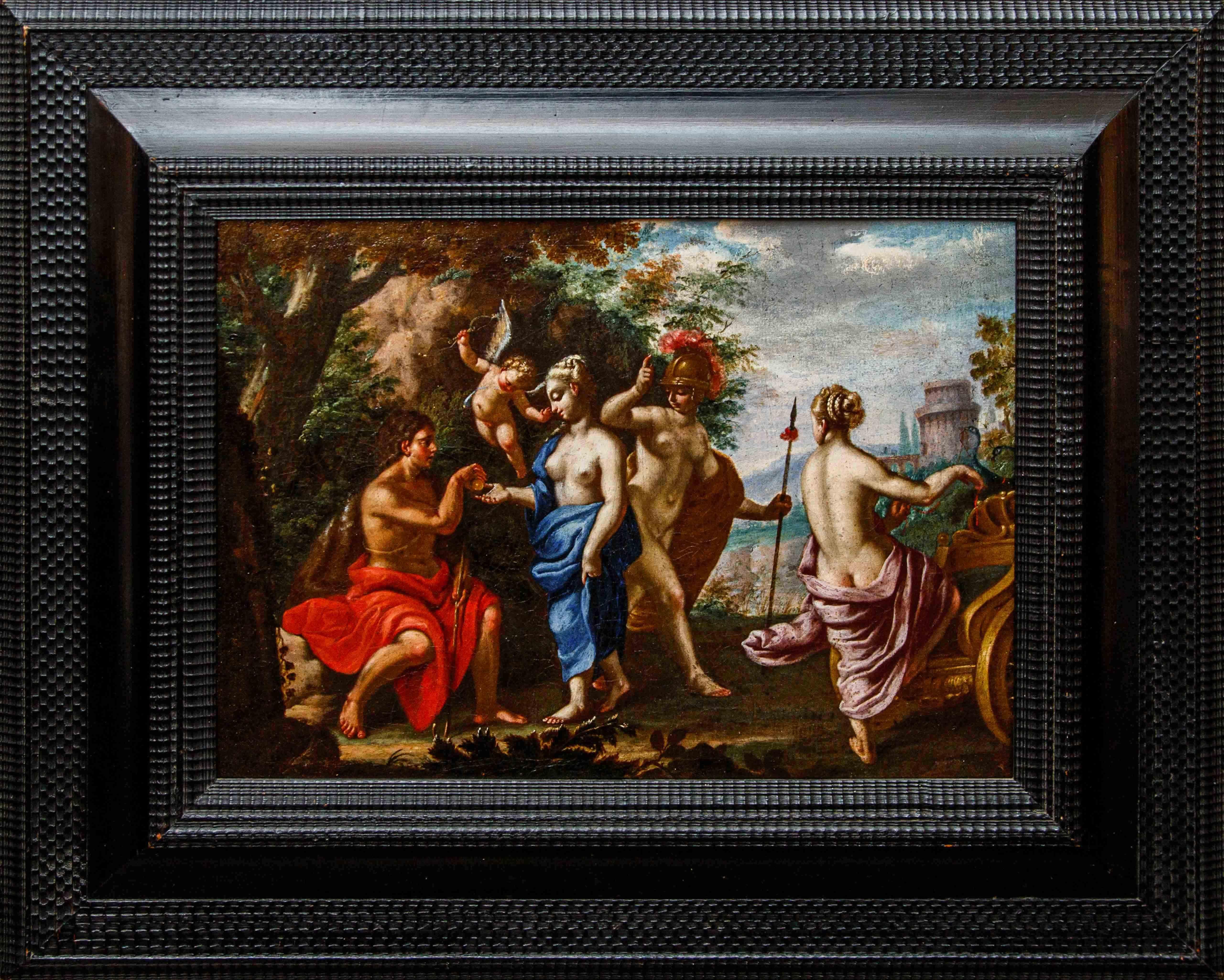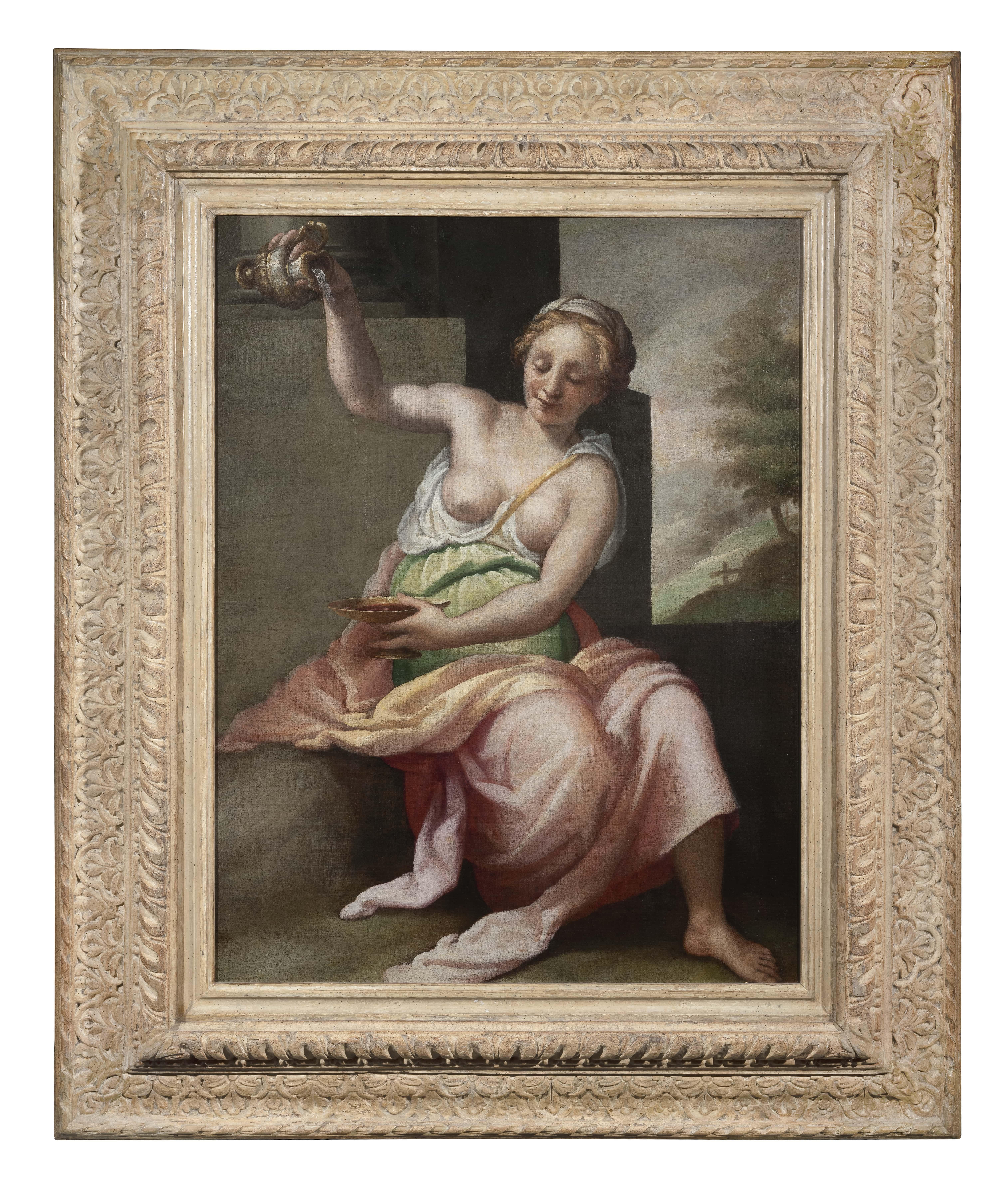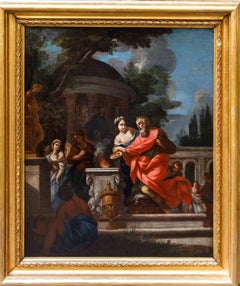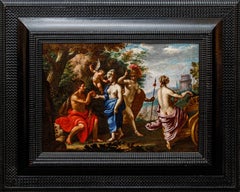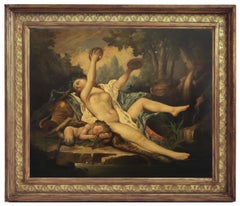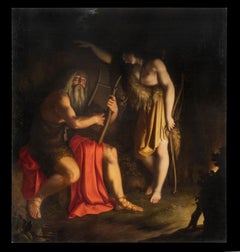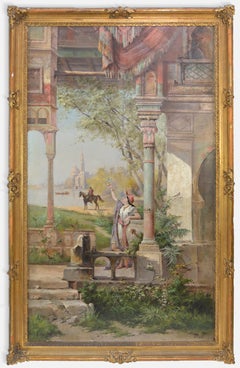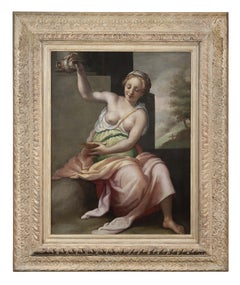Items Similar to Giacomo Casa (Conegliano, 1827 - Rome, 1887), Allegory of Venice
Want more images or videos?
Request additional images or videos from the seller
1 of 13
Giacomo Casa (Conegliano, 1827 - Roma, 1887)Giacomo Casa (Conegliano, 1827 - Rome, 1887), Allegory of Venice19th Century
19th Century
$6,850.12
£5,157.10
€5,800
CA$9,436.50
A$10,568.28
CHF 5,514.36
MX$129,087.02
NOK 70,158.66
SEK 66,132.95
DKK 44,150.39
About the Item
Giacomo Casa (Conegliano, 1827 - Rome, 1887)
Allegory of Venice
Oil on canvas, 50.5 x 40 cm
With frame 65.5 x 53.5 cm
The Unification of Italy and its historical and political journey fueled the production of specific works of art, evoking war scenes, political and popular episodes, but also complex allegorical depictions. Typical of this illustrative strand is the painting under consideration, recognized to Giacomo Casa (1827-1887) given the stylistic and compositional consonances with his typical pictorial production, as well as for the direct relationship, given the iconographic scheme and the elegant decorative figure, with the allegorical work depicting Republican Venice resurrected to freedom and art, with the tricolor flag, executed in 1848 by Casa and now preserved at the Museum of the Risorgimento and Resistance in Vicenza.
A painting with strong patriotic significance, it features a female figure in the center, which can be identified with the Allegory of Venice: the setting in a rural landscape differs from the port and seascape found in the Vicenza painting but would indicate the Venetian power extended into the Venetian and Lombardy hinterlands throughout the history of the maritime republic; moreover, the lion's presence should be interpreted as a clear reference to the main symbol of the lagoon city, depicted along with the usual attributes of arms, shown at her feet and with laurel wreaths beside her, leading back to military glories. Further patriotic reference, is the depiction of the woman with bare breasts, thus alluding to her function as Mother, while the color combination of the robe and the cloth resting on the broken column refer to the Tricolor, the national banner adopted since 1797 with the Cispadane Republic until it became one of the most important symbols of the Risorgimento and the Unification of Italy. The warrior holds an oak branch in her right hand, a reference to the military valor that the nation is ready to employ for its redemption, while the broken column commemorates those who have fallen for the homeland. A typical Veneto landscape unfolds in the background, reminiscent of the lagoon tradition in the shading and clear, smoky skies of Bellini and Titian, exhibiting a remarkable formal elegance and refined chromatics of 16th-century Venetian taste. The definition of this subject, which interprets the allegorical figure of Venice from a Risorgimento perspective, took place starting with the uprisings of 1848, in which the city had the brief but intense experience of the Republic of St. Mark, formed by Daniele Manin in an anti-Austrian function and later approaching annexation to the Kingdom of Sardinia, which then took place after the Third War of Independence with the plebiscite of 1866. During these years, Casa developed lithographs and engravings, preserved today at the Institute for the History of the Italian Risorgimento in Rome, in order to praise the patriotic heroes and martyrs who fought to gain independence from the Habsburgs and annexation to the Savoy kingdom, thus succeeding in reworking Venetian symbols from a patriotic and fusion perspective with the future Kingdom of Italy.
His youthful experiences, both artistic and otherwise, helped solidify Casa's ideas: as a painter he trained at the Venice Academy, Giacomo Casa was a pupil of Molmenti, who contributed to the development of his rare talent and distinct personality. In his early twenties, he participated in the Venetian revolutionary uprisings between 1848 and 1850. He visited Padua, Naples, Rome, Pompeii, Catania and had experiences abroad, in the East, Paris and London, where he stayed for a few years. In 1883, he returned to Italy for good and settled in Rome.
Right from the start his creations found appreciation, as evidenced by his participation in numerous exhibitions: after the uprisings of '48 he took part in the Venetian exhibitions, in 1861 he presented himself with Episodio dei Promessi Sposi while in 1862 he proposed Diluvio Universale and La beneficenza. At the First Italian Exhibition in Florence in 1861 he exhibited his best-known work, Michelangelo directing fortification work in Florence.
The Casa was also a skilled and in-demand fresco painter, one recalls his works executed during the 1850s in Venice alongside L. Cadorin (Caffè delle Nazioni, 1857; Caffè Florian, 1858; Caffè Quadri, 1859; Palazzina Foscari; Palazzina Gattei Nardi, 1864; interventions in the Royal Palace and in Palazzo Papadopoli in Santa Marina). In 1884 he was commissioned to decorate the Verdi Theater in Padua, where he intervened in the ceilings of several rooms with allegorical depictions. He worked at the church of the Filippini in Chioggia; he was active not only for the Venetian churches of San Moisè and Santa Maria Formosa but also for the Apollonian halls of the Teatro La Fenice in Venice.
In easel painting he also treated Orientalist themes that contributed to his notoriety (Mercato orientale, 1885, Venice, Galleria d'Arte Moderna di Ca' Pesaro). His works, mostly genre and historical subject paintings, e.g., Venice welcomes Victor Emmanuel II, are preserved in the Museums of Udine, Padua, Bassano, and the Museum of Modern Art in Venice.
- Creator:Giacomo Casa (Conegliano, 1827 - Roma, 1887) (Italian)
- Creation Year:19th Century
- Dimensions:Height: 19.69 in (50 cm)Width: 15.75 in (40 cm)
- More Editions & Sizes:50x40Price: $6,850
- Medium:
- Period:
- Condition:
- Gallery Location:Milan, IT
- Reference Number:1stDibs: LU2639216356232
About the Seller
No Reviews Yet
Vetted Professional Seller
Every seller passes strict standards for authenticity and reliability
1stDibs seller since 2023
Typical response time: <1 hour
- ShippingRetrieving quote...Shipping from: Milan, Italy
- Return Policy
Authenticity Guarantee
In the unlikely event there’s an issue with an item’s authenticity, contact us within 1 year for a full refund. DetailsMoney-Back Guarantee
If your item is not as described, is damaged in transit, or does not arrive, contact us within 7 days for a full refund. Details24-Hour Cancellation
You have a 24-hour grace period in which to reconsider your purchase, with no questions asked.Vetted Professional Sellers
Our world-class sellers must adhere to strict standards for service and quality, maintaining the integrity of our listings.Price-Match Guarantee
If you find that a seller listed the same item for a lower price elsewhere, we’ll match it.Trusted Global Delivery
Our best-in-class carrier network provides specialized shipping options worldwide, including custom delivery.More From This Seller
View All17th century, Bottega of Giovanni Francesco Romanelli, The Idolatry of Solomon
Located in Milan, IT
17th century, Roman School
Workshop of Giovanni Francesco Romanelli, known as the Viterbese (Viterbo, c. 1610 -1662)
Solomon's idolatry
Oil on canvas, 73.5 x 59.5 cm
The painting...
Category
17th Century Other Art Style Landscape Paintings
Materials
Canvas, Oil
Girolamo Maria Pesci (Rome, 1679 - 1759), The judgment of Paris
Located in Milan, IT
Girolamo Maria Pesci (Rome, 1679 - 1759)
The judgment of Paris
c. 1705-1710
Oil on canvas, 47 x 36.5 cm
Girolamo Maria Pesci (Rome, 1679 - 1759), a figure distinguished for his e...
Category
18th Century and Earlier Other Art Style Figurative Paintings
Materials
Canvas, Oil
By Jean Louis Victor Viger de Vigneau (Argentan, 1819- Paris, 1879), Cleopatra
Located in Milan, IT
Jean Louis Victor Viger de Vigneau (Argentan, 1819- Paris, 1879)
The Death of Cleopatra
Oil on panel, 21 x 28 cm
Framed, 34 x 39 cm
Signed at lower right "H. Viger. D."
Born in Argentan, Normandy, into a family of humble origins, at a very young age Viger de Vigneau, given his precocious and pronounced talent, was initiated into the painting profession, attending the graphic arts school founded in Rouen by Raymond Quinsac Monvoisin, a pupil of the famous Pierre Narcisse Guerin...
Category
19th Century Other Art Style Nude Paintings
Materials
Oil, Board
From Paolo Veronese, Allegory of Strength and Wisdom
By Paolo Veronese
Located in Milan, IT
Follower of Paolo Veronese (Verona, 1528 - Venice, 1588)
Allegory of wisdom and strength
Oil on canvas, 48 x 36.5 cm
Picture frame, 61 x 48 cm
The Allegory of Wisdom and Strength...
Category
16th Century Other Art Style Figurative Paintings
Materials
Canvas, Oil
Paolo Monaldi (Rome, 1710 - after 1779), attr. , Genre scene
Located in Milan, IT
Paolo Monaldi (Rome, 1710 - after 1779), attr.
Genre scene
Oil on canvas, 28 x 38 cm
Framed, 36.5 x 46 cm
The canvas depicts a moment of repose drawn from the rural world: the...
Category
18th Century and Earlier Other Art Style Figurative Paintings
Materials
Canvas, Oil
Paolo Monaldi (Rome, c. 1704 - post 1779), Genre Scene
Located in Milan, IT
Paolo Monaldi (Rome, c. 1704 - post 1779)
Genre scene
Oil on canvas, 50 x 63 cm
Framed, 65 x 80 cm
In the lively artistic scene of 18th-century Rome, dominated by big names and ...
Category
18th Century and Earlier Other Art Style Figurative Paintings
Materials
Canvas, Oil
You May Also Like
ALLEGORICAL SCENE - Giovanni Faliero - Italy Oil on Canvas Painting
By Giovanni Faliero
Located in Napoli, IT
Allegorical Scene - Giovanni Faliero Italia 2009 - Oil on canvas cm. 90x110.
Gold leaf gilded wooden frame available on request
This beautiful oil on canvas is the personal reinterpretation of the magnificent painting “Bacchant playing the Cymbals” by Jean-Simon Berthélemy, a French painter of the 18th century. Here we admire a mythological scene showing a naked bacchant playing cymbals next to a wooded stream, with a small sleeping faun...
Category
Early 2000s Old Masters Portrait Paintings
Materials
Canvas, Oil
Mythological figurative painting of 19th century Italian Romanticism
Located in Florence, IT
The painting depicts "Ossian tells Malvina about the exploits of his son Oscar" and is dated at lower right "Filippo Bellati did the year 1811" and the unframed measurements are 233 ...
Category
1810s Romantic Figurative Paintings
Materials
Canvas, Oil
Oriental Scene - Oil Paint by Giulio Rosati - 19th Century
Located in Roma, IT
Oriental scene is an orientalist artwork realized by Giulio Rosati (1857 – 1917) .
The artwork depicts an oriental palace with lady and horse rider in l...
Category
1970s Modern Figurative Paintings
Materials
Oil
Late 16th Century by Jacopo da Empoli Temperance Oil on canvas
Located in Milano, Lombardia
Jacopo da Empoli (Florence, Italy, 1551 – 1640)
Title: Temperance
Medium: Oil on canvas
Dimensions: without frame 101.5 x 75.7 cm – with frame 140 x 115.3 x 10.50 cm
Expertise by Al...
Category
16th Century Old Masters Figurative Paintings
Materials
Canvas, Oil
NEOCLASSICAL FIGURE -In theManner of J. W. Godward Italy Oil on canvas painting
By Eugenio De Blasi
Located in Napoli, IT
Sweet Dreams - Oil on canvas painting, Eugenio De Blasi, Italy, 2011
Gold leaf gilded wooden frame cm. 134x94
The painting by Eugenio De Blasi is inspired by the painting "Sweet Dreams" by John William Godward, a neoclassical Victorian painter...
Category
2010s English School Figurative Paintings
Materials
Canvas, Oil
Pair Italian Oil Paintings Grand Tour Roman Scenes Annibale Gatti 19th century
By Annibale Gatti
Located in Rochester, NY
Pair of Roman scenes attributed to Annibale Gatti. Inscribed on reverse "A Gatti". 19th century. Oil on board. Paintings measure 14.5" x 4.5" without frames.
Category
19th Century Figurative Paintings
Materials
Oil

